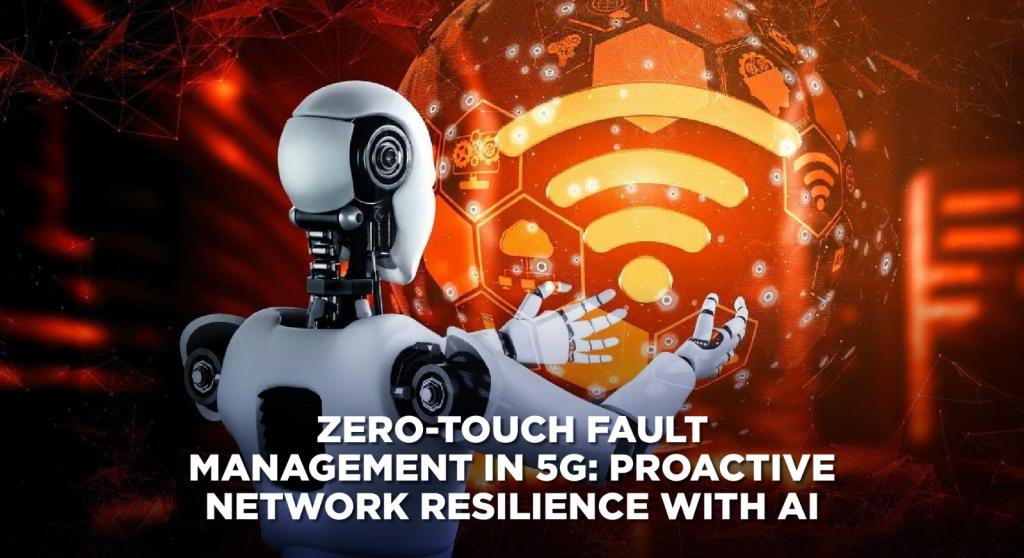With the advent of 5G, the telecommunications sector is undergoing a significant transformation. While promising unprecedented capabilities, 5G also introduces complexities like network disaggregation, virtualization, and edge computing. Traditional, reactive fault management approaches, which address issues only after they occur, are no longer viable. They are too slow, error-prone, and costly for the dynamic and intricate 5G environment. The imperative now is to shift towards proactive, intelligent, and automated fault management—a paradigm embodied by Zero-Touch Fault Management (ZTFM).
Zero-Touch Fault Management leverages Artificial Intelligence (AI) and Machine Learning (ML) to move from reactive “firefighting” to predictive prevention and autonomous resolution. It not only ensures the ultra-reliability and operational efficiency demanded by 5G but also optimizes operational expenses (OpEx), safeguarding revenue and fostering customer loyalty by minimizing downtime and enhancing service quality.
Understanding Zero-Touch Fault Management (ZTFM) and Autonomous Network
Zero-Touch Fault Management represents a significant paradigm shift in telecom network management, aiming for an autonomous network operation model where networks can dynamically “heal and adjust themselves” with minimal human intervention. It goes beyond merely resolving issues faster; it’s about creating a more stable and robust network by preemptively detecting and fixing problems, thereby eliminating potential errors from manual processes.
Table 1: Traditional vs. AI-Powered Fault Management Comparison
Aspect | Traditional Fault Management | AI-Powered Zero-Touch Fault Management |
Approach | Reactive, Manual/Scripted | Proactive, Predictive, Autonomous |
Fault Detection | Alarm-based, Threshold monitoring, Manual log review | Automated Anomaly Detection, Pattern Recognition, Real-time Telemetry Analysis |
Resolution | Manual intervention, Scripted fixes, Human decision-making | Automated Remediation, Self-healing actions, AI-driven solutions |
Human Intervention | High, Daily operational tasks | Minimal, Strategic oversight, Policy definition |
Cost Impact | High OpEx due to downtime, manual labor, and delayed resolution | Reduced OpEx, Predictive maintenance savings, Minimized downtime |
Network Complexity | Struggles with diverse vendor environments, virtualized functions | Excels with multi-vendor, disaggregated, virtualized 5G networks |
The AI and Machine Learning Engine Behind Zero-Touch Fault Management
Advanced AI and ML are the technological cornerstones of Zero-Touch Fault Management, enabling a level of autonomous network and intelligence previously unattainable.
Predictive Maintenance: AI/ML algorithms continuously monitor network equipment in real-time, analyzing data to predict failures before they occur. This proactive approach minimizes service disruptions and extends the lifespan of the infrastructure.
Automated Root Cause Analysis (RCA): Fault identification is accelerated by AI-driven Root Cause Analysis (RCA) systems. These systems quickly process extensive data from numerous integrated systems to precisely determine the origin of a problem. It significantly decreases the Mean Time To Repair (MTTR) by automating a process that typically requires skilled engineers to spend a considerable amount of time.
Advanced Anomaly Detection & Correlation: AI/ML systems identify network irregularities by establishing baselines of normal behavior and flagging deviations. They perform correlation analysis across layers and data sources, linking events to provide context, which reduces alert noise and false alarms and helps pinpoint root causes.
AIOps Integration: AIOps platforms enhance IT operations by integrating AI and ML, boosting efficiency and reducing operational costs. They aggregate data, organize it into actionable incidents, and enable intelligent alerting, often automating simple remediation tasks.

Predictive Maintenance: AI/ML algorithms continuously monitor network equipment in real-time, analyzing data to predict failures before they occur. This proactive approach minimizes service disruptions and extends the lifespan of the infrastructure.
Automated Root Cause Analysis (RCA): Fault identification is accelerated by AI-driven Root Cause Analysis (RCA) systems. These systems quickly process extensive data from numerous integrated systems to precisely determine the origin of a problem. It significantly decreases the Mean Time To Repair (MTTR) by automating a process that typically requires skilled engineers to spend a considerable amount of time.
Advanced Anomaly Detection & Correlation: AI/ML systems identify network irregularities by establishing baselines of normal behavior and flagging deviations. They perform correlation analysis across layers and data sources, linking events to provide context, which reduces alert noise and false alarms and helps pinpoint root causes.
AIOps Integration: AIOps platforms enhance IT operations by integrating AI and ML, boosting efficiency and reducing operational costs. They aggregate data, organize it into actionable incidents, and enable intelligent alerting, often automating simple remediation tasks.
Collaborative AI Agents: The future envisions specialized AI agents working together, each focusing on specific network domains, collecting domain-specific data, and collaborating to resolve issues. This distributed model enhances scalability, resilience, and accuracy.
Table 2: Key AI/ML Applications in Zero-Touch Fault Management for Telecom
| AI/ML Application | Description | Key Benefits |
| Predictive Maintenance | Anticipates equipment failures and performance degradation before they occur by analyzing real-time and historical data. | Minimizes downtime, reduces operational costs, and extends asset lifespan. |
| Automated Root Cause Analysis (RCA) | Rapidly identifies the underlying causes of complex network issues by correlating vast amounts of data. | Accelerates incident resolution, significantly reduces Mean Time To Resolution (MTTR), and shifts from reactive to proactive troubleshooting. |
| Advanced Anomaly Detection & Correlation | Detects unusual patterns and deviations from normal network behavior, linking related events across multiple architectural layers. | Reduces false alarms, provides full context for issues, enables faster remediation. |
| AIOps Platforms | Integrates AI and ML into IT operations to automate processes, manage alarms, and provide intelligent insights for network health. | Improves operational efficiency, reduces operating expenses (OpEx), and enhances network performance and reliability. |
| Self-Healing Networks | Autonomous networks can automatically identify, diagnose, and resolve faults without human intervention. | Maximizes network uptime, reduces human error, and increases overall network resilience. |
Zero-Touch Fault Management in 5G Networks: Addressing Unique Challenges
Zero-Touch Fault Management, powered by AI, is uniquely positioned to address the novel and complex fault management challenges introduced by 5G’s intricate architecture and evolving ecosystem.
Network Slicing: 5G network slicing enables the creation of multiple virtual networks on a shared infrastructure. Zero-Touch Fault Management is crucial for managing faults within these slices, preventing issues from spreading, and ensuring Service Level Agreements (SLAs) are maintained through AI-driven monitoring.
Edge Computing: The growth of edge computing distributes data processing closer to its sources, vital for ultra-low-latency applications. Zero-Touch Fault Management offers proactive fault management for these distributed edge devices and applications, maintaining real-time data processing and connectivity.
Open RAN (O-RAN) Deployments: O-RAN’s disaggregated, multi-vendor approach increases susceptibility to faults. AI-driven Zero-Touch Fault Management frameworks use multi-level telemetry to predict faults in virtualized O-RAN deployments, enhancing network resilience.
Digital Twin Technology: Digital Twins provide a virtual replica of the physical network, enabling fault diagnosis in 5G environments where traditional methods struggle due to data scarcity. They discover and predict failures in the virtual twin, precisely locating faults in the physical network in real-time.
Table 3: 5G-Specific Fault Management Challenges & Zero-Touch Fault Management Solutions
| 5G Challenge | Description of Challenge | ZTFM/AI Solution | Benefits |
| Network Slicing Complexity | Managing faults and ensuring isolation across multiple virtual networks on shared infrastructure. | AI-driven monitoring for slice-specific QoS, resource allocation, and isolation breach detection. | Guarantees SLA for diverse services, prevents cross-slice contamination. |
| Edge Computing Distribution | Proactive fault management for highly distributed infrastructure at the network edge. | Predictive maintenance and automated RCA for edge devices, real-time anomaly detection at the source. | Ensures low-latency service continuity and reduces localized downtime. |
| Open RAN (O-RAN) Disaggregation | Fault prediction and resilience in multi-vendor, disaggregated network components. | Multi-level telemetry analysis for O-RAN fault prediction and automated configuration validation. | Enhances resilience in heterogeneous environments and reduces troubleshooting time. |
| Data Scarcity/Complexity for AI | Lack of sufficient labeled fault data and overwhelming complexity for training robust AI models. | Digital Twin models for fault simulation, synthetic data generation, and real-time diagnosis in a virtual environment. | Accelerates AI model training, improves prediction accuracy, enables “what-if” analysis. |
Types of Telecom Network Faults and Zero-Touch Fault Management Mitigation
Zero-Touch Fault Management, with its AI capabilities, fundamentally changes how various telecom network faults are addressed:
Implementing Zero-Touch Fault Management: Best Practices
Successful Zero-Touch Fault Management implementation requires a strategic approach beyond just technological deployment, such as:
Ensuring Data Quality and Seamless Integration: Zero-Touch Fault Management systems heavily rely on high-quality, clean, consistent, and integrated data from across the organization. Seamless integration of ZTFM tools with Network Management Systems (NMS), Operations Support Systems (OSS), and Business Support Systems (BSS) is crucial.
Phased Adoption Strategies and Scalability: An iterative implementation approach, starting with pilot AI projects in targeted areas, is recommended. Zero-touch fault management systems must be scalable to handle growing network loads, data volumes, and expanding network elements in complex 5G and edge computing environments.
Balancing Automation with Human Oversight: While Zero-Touch Fault Management strives for minimal human intervention, complex issues and ethical considerations still require human input. The roles of network engineers will evolve from manual tasks to strategic planning and overseeing automated systems.
Addressing Security Implications: Zero-Touch Fault Management enhances security by consistently applying policies, but highly automated and disaggregated environments introduce new attack vectors. Robust security measures, prioritizing data privacy, reliability, and accountability, must be integrated from the start.

The Future of Autonomous Networks: Beyond Zero-Touch
The evolution of telecom networks is progressing towards self-healing, self-optimizing, and fully autonomous networks, underpinned by continuous learning and adaptive intelligence.
The ultimate goal is inherently resilient, efficient, and proactive networks that continuously adjust parameters for optimal performance, anticipating and responding to their environment. This moves beyond mere fault management to continuous performance optimization and a shift from operations-centric to business-outcome-driven design.
Future networks will continuously train and refine AI models using both real-time and historical data to achieve more accurate fault prediction and prevention. Proactive fault management in telecommunications will significantly rely on AI and predictive analytics. Intent-based networking will enable operators to define business outcomes, with AI-driven Zero-Touch Fault Management translating intent into configurations, monitoring compliance, and autonomously managing faults.
Innovile is strategically positioned to play a pivotal role in this evolution. Its offerings, such as the INNSPECT Telecom Network Fault Management solution, are designed to empower telecom operators in their transition towards proactive, AI-driven, zero-touch fault management. By leveraging Innovile’s expertise, operators can enhance network resilience, optimize operational efficiency, and deliver a superior customer experience, thereby future-proofing their telecommunications networks for the 5G era and beyond, particularly within the context of autonomous networks.
